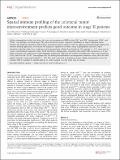Files in this item
Spatial immune profiling of the colorectal tumor microenvironment predicts good outcome in stage II patients
Item metadata
| dc.contributor.author | Nearchou, Ines P. | |
| dc.contributor.author | Gwyther, Bethany M. | |
| dc.contributor.author | Georgiakakis, Elena C. T. | |
| dc.contributor.author | Gavriel, Christos | |
| dc.contributor.author | Lillard, Kate | |
| dc.contributor.author | Kajiwara, Yoshiki | |
| dc.contributor.author | Ueno, Hideki | |
| dc.contributor.author | Harrison, David James | |
| dc.contributor.author | Caie, Peter David | |
| dc.date.accessioned | 2020-05-21T10:30:02Z | |
| dc.date.available | 2020-05-21T10:30:02Z | |
| dc.date.issued | 2020-05-15 | |
| dc.identifier | 267524839 | |
| dc.identifier | 78af5f1c-f00e-4c5a-a4f3-d892a12e9b67 | |
| dc.identifier | 000536096000001 | |
| dc.identifier | 85088068233 | |
| dc.identifier.citation | Nearchou , I P , Gwyther , B M , Georgiakakis , E C T , Gavriel , C , Lillard , K , Kajiwara , Y , Ueno , H , Harrison , D J & Caie , P D 2020 , ' Spatial immune profiling of the colorectal tumor microenvironment predicts good outcome in stage II patients ' , npj Digital Medicine , vol. 3 , 71 . https://doi.org/10.1038/s41746-020-0275-x | en |
| dc.identifier.issn | 2398-6352 | |
| dc.identifier.other | ORCID: /0000-0001-9041-9988/work/74510266 | |
| dc.identifier.other | ORCID: /0000-0002-0031-9850/work/74510315 | |
| dc.identifier.other | ORCID: /0000-0002-1863-5413/work/75610531 | |
| dc.identifier.uri | https://hdl.handle.net/10023/19977 | |
| dc.description | This study was funded by Medical Research Scotland and Indica Labs, Inc., who also provided in-kind resource. | en |
| dc.description.abstract | Cellular subpopulations within the colorectal tumor microenvironment (TME) include CD3+ and CD8+ lymphocytes, CD68+ and CD163+ macrophages, and tumor buds (TBs), all of which have known prognostic significance in stage II colorectal cancer. However, the prognostic relevance of their spatial interactions remains unknown. Here, by applying automated image analysis and machine learning approaches, we evaluate the prognostic significance of these cellular subpopulations and their spatial interactions. Resultant data, from a training cohort retrospectively collated from Edinburgh, UK hospitals (n = 113), were used to create a combinatorial prognostic model, which identified a subpopulation of patients who exhibit 100% survival over a 5-year follow-up period. The combinatorial model integrated lymphocytic infiltration, the number of lymphocytes within 50-μm proximity to TBs, and the CD68+/CD163+ macrophage ratio. This finding was confirmed on an independent validation cohort, which included patients treated in Japan and Scotland (n = 117). This work shows that by analyzing multiple cellular subpopulations from the complex TME, it is possible to identify patients for whom surgical resection alone may be curative. | |
| dc.format.extent | 10 | |
| dc.format.extent | 2601666 | |
| dc.language.iso | eng | |
| dc.relation.ispartof | npj Digital Medicine | en |
| dc.subject | Colorectal cancer | en |
| dc.subject | Image analysis | en |
| dc.subject | Tumor microenvironment | en |
| dc.subject | Prognosis | en |
| dc.subject | Digital pathology | en |
| dc.subject | RC0254 Neoplasms. Tumors. Oncology (including Cancer) | en |
| dc.subject | RB Pathology | en |
| dc.subject | QA76 Computer software | en |
| dc.subject | NDAS | en |
| dc.subject | SDG 3 - Good Health and Well-being | en |
| dc.subject.lcc | RC0254 | en |
| dc.subject.lcc | RB | en |
| dc.subject.lcc | QA76 | en |
| dc.title | Spatial immune profiling of the colorectal tumor microenvironment predicts good outcome in stage II patients | en |
| dc.type | Journal article | en |
| dc.contributor.institution | University of St Andrews. Cellular Medicine Division | en |
| dc.contributor.institution | University of St Andrews. School of Medicine | en |
| dc.contributor.institution | University of St Andrews. Sir James Mackenzie Institute for Early Diagnosis | en |
| dc.contributor.institution | University of St Andrews. Centre for Biophotonics | en |
| dc.identifier.doi | https://doi.org/10.1038/s41746-020-0275-x | |
| dc.description.status | Peer reviewed | en |
This item appears in the following Collection(s)
Items in the St Andrews Research Repository are protected by copyright, with all rights reserved, unless otherwise indicated.

